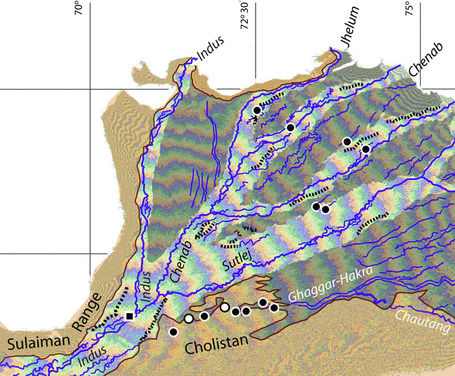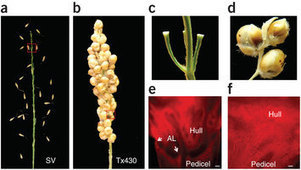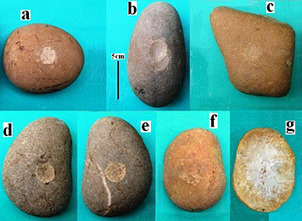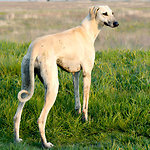The collapse of the Bronze Age Harappan, one of the earliest urban civilizations, remains an enigma. Urbanism flourished in the western region of the Indo-Gangetic Plain for approximately 600 y, but since approximately 3,900 y ago, the total settled area and settlement sizes declined, many sites were abandoned, and a significant shift in site numbers and density towards the east is recorded. We report morphologic and chronologic evidence indicating that fluvial landscapes in Harappan territory became remarkably stable during the late Holocene as aridification intensified in the region after approximately 5,000 BP. Upstream on the alluvial plain, the large Himalayan rivers in Punjab stopped incising, while downstream, sedimentation slowed on the distinctive mega-fluvial ridge, which the Indus built in Sindh. This fluvial quiescence suggests a gradual decrease in flood intensity that probably stimulated intensive agriculture initially and encouraged urbanization around 4,500 BP. However, further decline in monsoon precipitation led to conditions adverse to both inundation- and rain-based farming. Contrary to earlier assumptions that a large glacier-fed Himalayan river, identified by some with the mythical Sarasvati, watered the Harappan heartland on the interfluve between the Indus and Ganges basins, we show that only monsoonal-fed rivers were active there during the Holocene. As the monsoon weakened, monsoonal rivers gradually dried or became seasonal, affecting habitability along their courses. Hydroclimatic stress increased the vulnerability of agricultural production supporting Harappan urbanism, leading to settlement downsizing, diversification of crops, and a drastic increase in settlements in the moister monsoon regions of the upper Punjab, Haryana, and Uttar Pradesh.
A key step in domestication of cereals was loss of seed shattering. Jianming Yu and colleagues show that seed shattering is controlled by alleles at Sh1 in sorghum.
Are these ancient Himalayan nut crackers?
Cooking makes foods more palatable and digestible, less toxic and suitable for longer-term storage. Starch granules usually undergo gelatinisation during cooking, resulting in the loss of native structure and morphology. Once fully gelatinised, starch is very difficult to recognise microscopically and to classify taxonomically, impeding identification of cooked starch in archaeological food residues. Gelatinisation involves a complex interplay between temperature, moisture content and the presence of solutes, lipids and proteins, as well as species-specific starch physicochemical properties. Understanding the influence of these factors, particularly moisture, on the degree and extent of starch conversion during heat treatment enables predictive models of native starch survival in archaeological samples based on cooking method and food type. The findings of this review indicate that differential native starch survival may significantly influence archaeobotanical reconstructions and interpretations of artefact function.
Little about the origins of dogs is agreed upon, beyond that they descended from wolves, and genetic research has provided little insight. There is a reason for this confusion, according to Greger Larson at the University of Durham in England. In a new research paper, he argues that the DNA of modern dogs is so mixed up that it is useless in figuring out when and where dogs originated. “With the amount of DNA we’ve sequenced so far,” Dr. Larson said, “we’re lucky to get back a hundred years, max.” He says that only with the analysis of DNA from fossil dogs, now being done, will answers along this line emerge.
|




